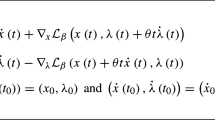Abstract
To approach a viable solution of a differential inclusion, i.e., staying at any time in a closed convexK, a sufficient condition is given implying the convergence of an approximation sequence defined from the Euler or Runge-Kutta methods applied to a selection process which corresponds to the slowsolution concept. WhenK is smooth, the convergence condition is satisfied. This proves that the method is implementable on a computer for solving, for instance, differentiable equations with a noncontinuous right-hand side. Since the usual best approximation operator is difficult to implement, we introduce a class of quasi-projectors much more suitable for computation.
Similar content being viewed by others
References
Aubin, J. P. Slow and heavy trajectories of controlled problems. Smooth viability domains. In Multifunctions and Integrands (edited by G. Salinetti). Lecture Notes in Mathematics, Vol. 1091. Springer-Verlag, Berlin (1984).
Aubin, J. P. Viability Theory (to appear).
Aubin, J. P., and Cellina, A. Differential Inclusions. Springer-Verlag, Berlin (1984).
Aubin, J. P., and Ekeland, I. Applied Nonlinear Analysis. Wiley, New York (1984).
Aubin, J. P., and Frankowska, H. Controllability of convex processes. SIAM J. Control Optim., 24 (1986), No. 6, 1192–1211.
Cornet, B., and Haddad, G. Viabilité pour les inclusions différentielles du 2d ordre. Israel J. Math., 57 (1987). MR 88d34015.
Cterna and Karwat, Semi-continuity of multifunction connected with optimisation with respect to cones. J. Australian Math. Soc. Ser. A, 40 (1986), No. 2, 183–193. MR87d49029.
De Blasi, F. S., and Myjak, J. On the set of solutions of a differential inclusion. Bull. Inst. Math. Acad. Sinica, 14 (1986), No. 3, 271–275.
Doutchev, A. L., and Vel'ov, V. M. Singular perturbation in linear differential inclusion—critical case. Parametric Optim. and Approx. (Obervolfach, 1983), pp. 108–125. Internat. Schrift. Numer. Math., Vol. 72. Birkhauser, Basel (1985).
Falcone, M., and Saint-Pierre, P. Slow and quasi-slow solutions of differential inclusions. NonLinear Anal. T.M.A., 11 (1987), No. 3, 367–377.
Frankowska, H., Adjoint differential inclusion in necessary conditions for the minimal trajectories of differential inclusions. Ann. Inst. H. Poincaré Anal. Non Linéaire, 2 (1985), No. 2, 75–99.
Haddad, G. Monotone viable trajectories for functional differential inclusions. J. Differential Equations, 42 (1981), 1–24.
Rubinov, A. M. The contingent derivative of a multivalued mapping and differentiability of the maximum under connected constraints. Sibirsk Mat. Zh, 26 (1985), No. 3, 147–155, 225. MR 87d49028.
Uryas'ev, S. P. The method of simple iterations for the solution of inclusion for multivalued mapping. Kibernetika (Kiev), IV (1985), No. 6, 115–116, 135. MR 87d90189.
Author information
Authors and Affiliations
Rights and permissions
About this article
Cite this article
Saint-Pierre, P. Approximation of slow solutions to differential inclusions. Appl Math Optim 22, 311–330 (1990). https://doi.org/10.1007/BF01447333
Accepted:
Issue Date:
DOI: https://doi.org/10.1007/BF01447333



